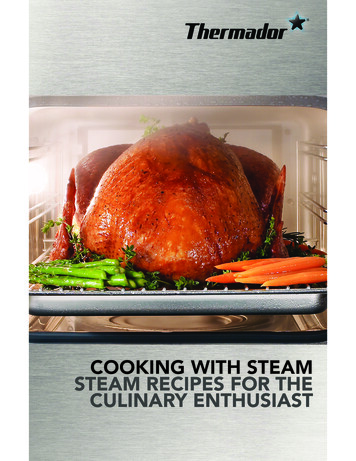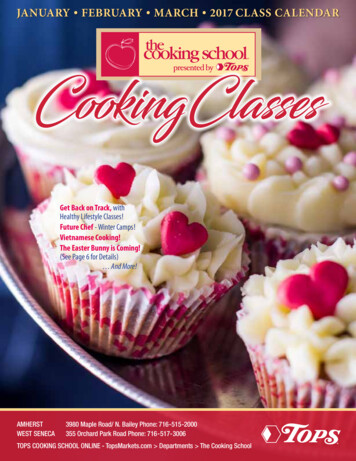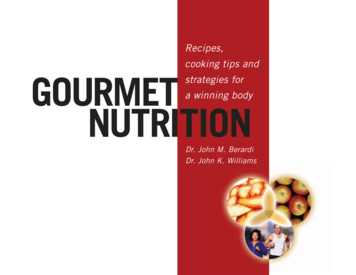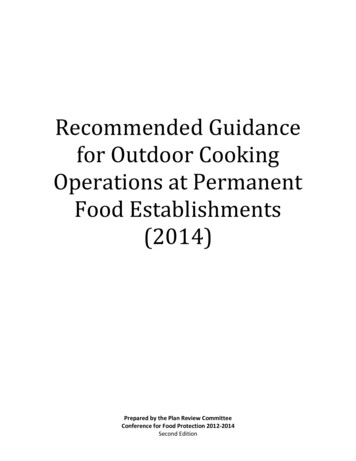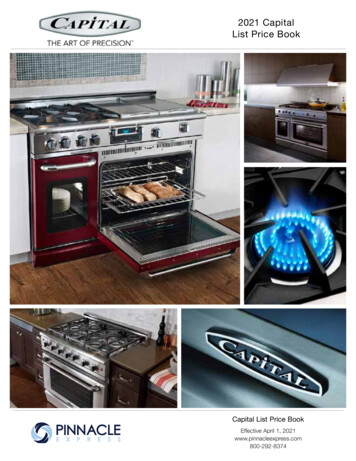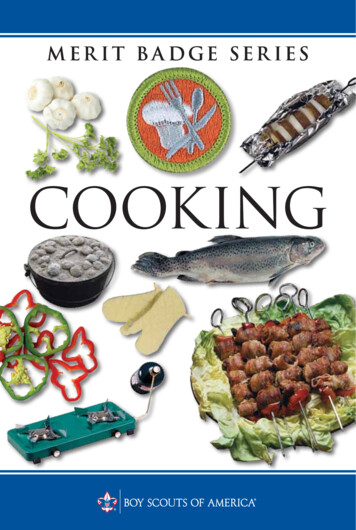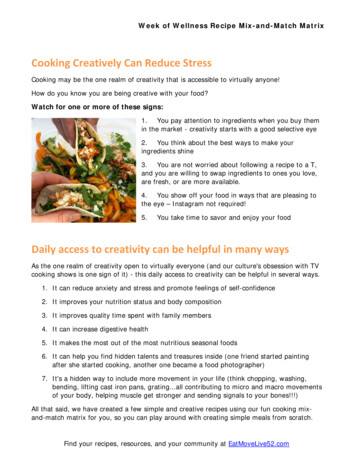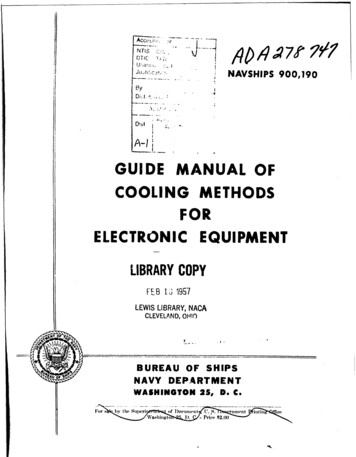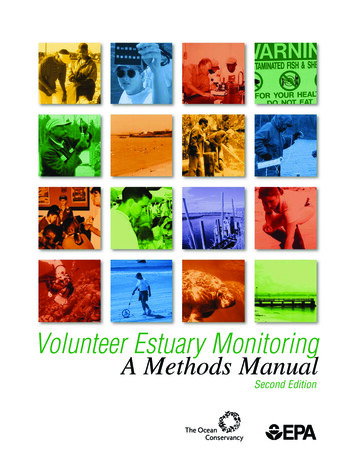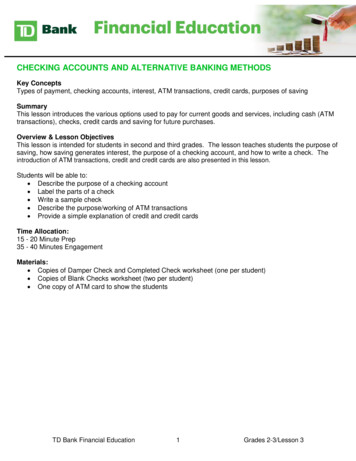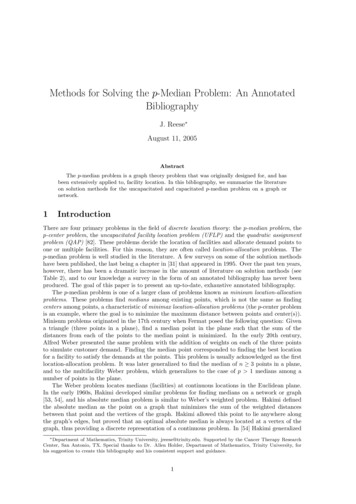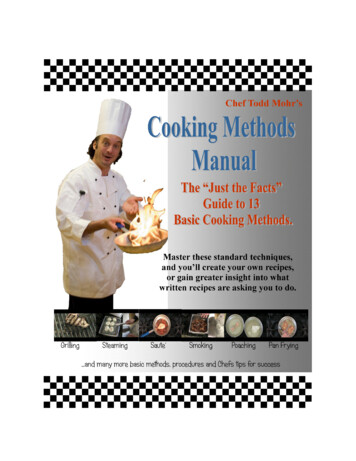
Transcription
Chef Todd Mohr’s Cooking Methods ManualChoosing the correct cooking method for the ingredients you are using is MUCH more importantthan finding the right recipe. Recipes only tell you WHAT to cook, and most often neglectinforming you HOW to cook. This guide is designed to give you the absolute bare-bones basicsof cooking methods to be used in your home.Cooking is the transfer of heat to food. This can be accomplished directly or indirectly. Directheat transfer is called “conductive”. Indirect heat transfer is termed “convective”.Convective cooking methods can be dry or moist. Roasting in the oven is a dry convectivemethod because it cooks indirectly with air. Poaching accomplishes the same result throughliquid.Combination cooking methods employ the advantages of dry conductive AND moist convectivemethods to add flavor and tenderize.After mastering these basic techniques, you’ll be able to create your own recipes, or gain greaterinsight into what most written recipes are asking you to do.It’s absolutely necessary to understand these principles so that you fully understand the finalresults in cooking that you are trying to achieve.“Burn Your Recipes, Volumes 1, 2, and 3” as well as the WebCookingClasses.com curriculumare referred to for additional information highlighted in BLUE.Chef Todd Mohr’s Cooking Methods ManualPage 1
WebCookingClasses.comTable of ContentsCooking Methods Table Summary .3Effects of Heat on Food Table .4Doneness Cooking Temperatures Table .4Broiling .5Grilling .6Roasting/Baking 7Sauteing .8Pan-Frying .9Deeep-Frying 10Smoking 11Poaching 12Simmering .13Boiling .14Steaming 15Braising .16Stewing .17Chef Todd Mohr’s Cooking Methods ManualPage 2
Heat tiveAirAirAirAirFatFatFatAirBroiler, flat pan w/rackGrillOven, flat pan w/sidesOven, baking panStove, sauté panStove, straight sided panPot filled with oilSmoker, stove-topLiquidLiquidSteamStove or oven, pan w/ sidesStove or oven, pan w/ sidesStove, pan w/rack & lidFat then LiquidFat then LiquidStove or oven, pan w/rackStove, stock potMoist-Heat veConvectiveCombination MethodsBraisingStewingBothBothChef Todd Mohr’s Cooking Methods ManualPage 3
WebCookingClasses.comEffects of Heat on Food:Temp FTemp CStage150-212f66-100cGelatinization of StarchesStarches absorb liquid and swell160-185f71-85cCoagulation of ProteinsProteins stiffen and shrink212f100cEvaporation of MoistureLiquid turns to gas320-338f160-170cCaramelization of SugarsSugars brown and become brittleDoneness TemperaturesFor Beef:Temp FTemp CStage125-130f51-55cVery 65-74cWell Done165f74cPoultry, Pork, Fish, GameChef Todd Mohr’s Cooking Methods ManualPage 4
WebCookingClasses.comDry-Heat Cooking MethodsDry-heat cooking methods use either conductive (direct) heat or convective (indirect) heat tocause changes in food products. Conductive heat will cook food items by applying direct flameor transfer of direct heat through a cooking vessel. Convective heat will cook food items bysurrounding food items with heated air.Broiling“Burn Your Recipes” Volume 3Broiling uses conductive heat applied from above the fooditem by electric element or flame. The proximity of thefood to the heat source makes this one of the quickest,most intense applications of heat in the kitchen.Procedure:1) Pre-heat broiler to highest setting.2) Pre-heat a broiler pan fitted with a rack to suspend the food above the pan3) Place the food item on the rack and the rack directly under the heat source.4) Control the amount of heat applied to the food item by raising or lowering the distancefrom the heat source.5) Observe the coagulation of proteins and turn the food item when cooked 75% on one side6) The item is finished when it reaches the desired internal temperatureTips:1) Be careful not to place the food item too close to the heat source. Surface sugars cancaramelize before internal proteins coagulate. In other words, you can burn the outsidebefore the inside is cooked.2) DO NOT close the oven door, leave it ajar. A closed environment creates convectiveheat rather than conductive heat.3) Preheat your broiler pan to give “grill marks” from the heated rack and reflect heat fromthe pan below the food item.4) Use broiling only for tender or thin items that can cook quickly.5) Captured drippings can be used in a sauce.Chef Todd Mohr’s Cooking Methods ManualPage 5
WebCookingClasses.comGrillingWebCookingClasses Week 4, 14, 15, 35“Burn Your Recipes” Volume 3Grilling is broiling turned upside down. Grilling uses conductive heatapplied from below by charcoal or wood combustion, electricelement, or flame. The direct heat of the grill is most probably themost intense heat available to you in your home. Propane gas grillscan generate heat of 100 BTU per square inch of grill. A 500 squareinch grill can produce 50,000 BTU of energy, much more than yourstove or oven.Grilling can impart a flavor to food that other methods are unable to reproduce. Charcoal orwood chips can add a smoky element to cooked foods. Even former burnt-on bits of the gas grillcan create a flavor that sauté cannot.Procedure:1) Preheat grill to highest setting with top lid closed to burn off material2) Decide which side of the food item will be the “show” side(facing up on the plate)3) Place the item on the grill with the “show” side down4) Cook long enough for grill marks to appear on the “show” side.5) Rotate the item 90 degrees and move to a new spot on the grill6) Turn the item when proteins have coagulated 75% of the wayup the side.7) The item is finished when it has reached the desired internal temperature.Tips:1) Preheat the grill with the lid closed to generate as much heat as possible, but always cookwith the lid OPEN. Closing the lid changes the cooking method from direct to indirect.2) Choose an item that is already tender and thin. This intense direct heat will not tenderizeitems; it will not fully cook very thick items.3) Avoid “flare-ups” with a spray bottle of water. Flare-ups may be fun to watch but areuncontrolled heat and can quickly burn your item.4) Consider marinating or dry-rubbing your item before cooking to add extra flavor to thequick, intense cooking method.5) Cook very delicate items like flaky white fish in a dry, but indirect cooking method byheating only one side of the grill and cooking on the opposite side with the lid closed.Chef Todd Mohr’s Cooking Methods ManualPage 6
WebCookingClasses.comRoasting and BakingWebCookingClasses Week 1, 24, 30, 31, 32, 33, 34, 45, 46“Burn Your Recipes” Volume 2 and 3Chef Todd’s Holiday Cooking Success CourseRoasting and baking are terms that are used interchangeably, but mostoften incorrectly. While both refer to a convective cooking processwhere food items are heated with dry air in an enclosed environment,Roasting is reserved for meats and poultry while Baking is reservedfor fish, vegetables, fruits, breads orpastries.Heat is applied to the outside of food items and penetrates byconduction. The exterior of the food item dehydrates and thenbrowns from caramelization.Procedure:1) Pre-heat oven to desired temperature2) Place item to be roasted or baked in the oven pan appropriate for the food item3) Turn the item 180 degrees mid-way through cooking4) Item is finished when it reaches desired internal temperature.Tips:1) Don’t trust the temperature your oven tells you. Get an oven thermometer to be assured.2) Use a pan appropriate for the item being cooked. Pans that are too small will affect theamount of heat reflected during the cooking process.3) Basting is a myth! DO NOT open the oven door during the cooking process.“Syringing” drippings back to the top of the meat is useless when letting 100 degrees oftemperature escape from the oven each time the door is opened.4) Items that are roasted of baked will dry out considerably. Consider having a sauce ready.5) Always let roasted or baked items rest after removing from the oven to allow for carryover cooking.Chef Todd Mohr’s Cooking Methods ManualPage 7
SautéingWebCookingClasses Week 2, 3, 18, 21, 28,“Burn Your Recipes, Volume 3”Sauté uses a conductive method to transfer dry heat from the source tothe bottom of a sauté pan, through to the food product being cooked.I consider sauté to be the “driving the car of cooking”. As opposed toroasting, sauté demands your constant attention and adjustment of thecooking process. If you can’t sauté, you are limiting the amount ofitems you can cook.Sauté uses high temperatures to cook quickly in a small amount offat. “Sauter” in French means “to jump”, referring to using thesloped sides of the sauteuse to toss foods, or the jumping of heateditems in the pan.Procedure:1) Preheat sauté pan on the stove top until droplets of water boil and evaporate immediately.2) Add a SMALL amount of fat to the pan, swirling the pan to cover the bottom.3) Heat the fat to just below the smoke point. Observe the fat changing from perfectlysmooth in the pan to streaky. This is the indicator of reaching the smoke point.4) Add your food item to the pan, “show” side down.5) If cut into pieces, toss to cook evenly. If one large piece use tongs to turn the item.6) Turn the item when cooked 75% on the first side. (observe coagulation of proteins)7) Either remove the food item to a plate, or leave in the pan to create a sauce.8) Add vegetables or aromatics to the pan, sautéing in the “fond” or pan drippings.9) Deglaze the pan with a cold liquid, releasing the fond, and dropping the temperature ofthe pan.10) Reduce the sauce to half its original volume.11) Add condiments, flavorings, seasonings to the pan sauce.12) If removed, return the food item to be cooked in a moist convective process.13) Item is finished when it reaches the desired internal temperature.Tips:1) Pre-heat the pan. The most common mistake is starting sauté with a cold pan.2) Food items for sauté should be as DRY as possible before cooking. The combination offat and water will create splattering, and the food will be steamed instead of sautéed.3) Control the heat. The sauté pan should be hot enough to create conduction of heat intothe item being cooked, but not so hot that the surface burns before the middle cooks.4) Consider cutting larger items into smaller pieces for the intense heat of sauté so they cookmore quickly and evenly.5) Do not crowd foods in the sauté pan. Cook in batches if necessary.6) Use pans without a non-stick surface to promote the development of fond, the basis to theflavor in your pan sauce.7) Always match deglazing liquids to the flavor profile of the dish you’re creating.8) Stir-Fry is the Asian cousin of French sauté, using the same method in a Wok.Chef Todd Mohr’s Cooking Methods ManualPage 8
WebCookingClasses.comPan Frying“Burn Your Recipes” Volume 3Pan frying differs from sauté in the amount of fat used in the pan.Food items that are pan-fried are immersed, but not submerged, in hotfat. 50% of the item is cooked in the fat. Pan frying is a dry cookingmethod because no water or stock is used.Heat is transferred through the direct conduction of the bottom of thepan, as well as the convection of the hot fat around the food item, which is usually breaded orsealed in some manner to retain moisture.Procedure:1) Add a correct amount of fat to have your food itemimmersed 50%. This can be estimated, or by measuringthe height of the food item and then the fat in the pan.2) Heat the fat until convection begins, or a small crumbbrowns quickly. Use a temperature lower than you would with sauté.3) Control the temperature of the fat with a thermometer. Fat that is too cold will allow thefood item to absorb fat. Fat that is too hot will burn the outside before cooking inside.4) The fat SHOULD NEVER SMOKE.5) Add your food item in a motion AWAY FROM YOU, so you are not splashed with fat.6) When the food is fully browned on one side, turn it over with tongs. Be careful not topuncture your breading and release moisture.7) The item is finished when it reaches the desired internal temperature.Tips:1) A proper breading procedure will give attractive eye-appeal and retain moisture in yourpan-fried item.2) Being burned by hot fat is very painful. Be careful not to drop items into hot fat. Placethem carefully into the cooking medium.3) Use of a thermometer is mandatory to tell the heat of the oil and doneness of the item.4) Fat used for pan frying can be re-used many times, but will take on the flavors of itemscooked previously. French Fries will taste fishy after frying fish.5) Never pour used fat down your sink. Used fat can be disposed in a metal can with papertowels or kitty litter.Chef Todd Mohr’s Cooking Methods ManualPage 9
WebCookingClasses.comDeep FryingDeep frying differs from pan frying in that the food item is totally submerged in hot fat. Deepfrying is a convective dry heat cooking process because it employs no water or stock in cooking.Heat is transferred through the direct conductive application of heat through the hot fat. Foods tobe deep fried are usually coated in a batter or breading to prevent absorption of fat and to retainmoisture.Procedure:1) Heat deep-fat fryer or stock pot with oil to desired temperature.2) Immerse food item in the heated fat3) There should be no need to turn the item, but if it floats too long on one side, flip it over.4) The item is finished when it reaches the
Combination cooking methods employ the advantages of dry conductive AND moist convective methods to add flavor and tenderize. After mastering these basic techniques, you’ll be able to create your own recipes, or gain greater insight into what most written recipes are asking you to do. It’s absolutely necessary to understand these principles so that you fully understand the final results in .
